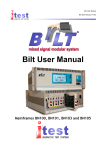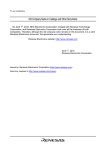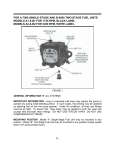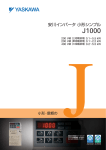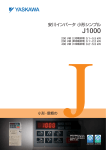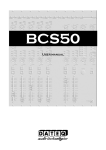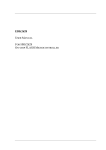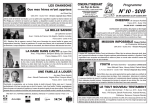Download Renesas Single-Chip Microcomputer SH7203 Technical information
Transcript
To our customers, Old Company Name in Catalogs and Other Documents On April 1st, 2010, NEC Electronics Corporation merged with Renesas Technology Corporation, and Renesas Electronics Corporation took over all the business of both companies. Therefore, although the old company name remains in this document, it is a valid Renesas Electronics document. We appreciate your understanding. Renesas Electronics website: http://www.renesas.com April 1st, 2010 Renesas Electronics Corporation Issued by: Renesas Electronics Corporation (http://www.renesas.com) Send any inquiries to http://www.renesas.com/inquiry. Notice 1. 2. 3. 4. 5. 6. 7. All information included in this document is current as of the date this document is issued. Such information, however, is subject to change without any prior notice. Before purchasing or using any Renesas Electronics products listed herein, please confirm the latest product information with a Renesas Electronics sales office. Also, please pay regular and careful attention to additional and different information to be disclosed by Renesas Electronics such as that disclosed through our website. Renesas Electronics does not assume any liability for infringement of patents, copyrights, or other intellectual property rights of third parties by or arising from the use of Renesas Electronics products or technical information described in this document. No license, express, implied or otherwise, is granted hereby under any patents, copyrights or other intellectual property rights of Renesas Electronics or others. You should not alter, modify, copy, or otherwise misappropriate any Renesas Electronics product, whether in whole or in part. Descriptions of circuits, software and other related information in this document are provided only to illustrate the operation of semiconductor products and application examples. You are fully responsible for the incorporation of these circuits, software, and information in the design of your equipment. Renesas Electronics assumes no responsibility for any losses incurred by you or third parties arising from the use of these circuits, software, or information. When exporting the products or technology described in this document, you should comply with the applicable export control laws and regulations and follow the procedures required by such laws and regulations. You should not use Renesas Electronics products or the technology described in this document for any purpose relating to military applications or use by the military, including but not limited to the development of weapons of mass destruction. Renesas Electronics products and technology may not be used for or incorporated into any products or systems whose manufacture, use, or sale is prohibited under any applicable domestic or foreign laws or regulations. Renesas Electronics has used reasonable care in preparing the information included in this document, but Renesas Electronics does not warrant that such information is error free. Renesas Electronics assumes no liability whatsoever for any damages incurred by you resulting from errors in or omissions from the information included herein. Renesas Electronics products are classified according to the following three quality grades: “Standard”, “High Quality”, and “Specific”. The recommended applications for each Renesas Electronics product depends on the product’s quality grade, as indicated below. You must check the quality grade of each Renesas Electronics product before using it in a particular application. You may not use any Renesas Electronics product for any application categorized as “Specific” without the prior written consent of Renesas Electronics. Further, you may not use any Renesas Electronics product for any application for which it is not intended without the prior written consent of Renesas Electronics. Renesas Electronics shall not be in any way liable for any damages or losses incurred by you or third parties arising from the use of any Renesas Electronics product for an application categorized as “Specific” or for which the product is not intended where you have failed to obtain the prior written consent of Renesas Electronics. The quality grade of each Renesas Electronics product is “Standard” unless otherwise expressly specified in a Renesas Electronics data sheets or data books, etc. “Standard”: 8. 9. 10. 11. 12. Computers; office equipment; communications equipment; test and measurement equipment; audio and visual equipment; home electronic appliances; machine tools; personal electronic equipment; and industrial robots. “High Quality”: Transportation equipment (automobiles, trains, ships, etc.); traffic control systems; anti-disaster systems; anticrime systems; safety equipment; and medical equipment not specifically designed for life support. “Specific”: Aircraft; aerospace equipment; submersible repeaters; nuclear reactor control systems; medical equipment or systems for life support (e.g. artificial life support devices or systems), surgical implantations, or healthcare intervention (e.g. excision, etc.), and any other applications or purposes that pose a direct threat to human life. You should use the Renesas Electronics products described in this document within the range specified by Renesas Electronics, especially with respect to the maximum rating, operating supply voltage range, movement power voltage range, heat radiation characteristics, installation and other product characteristics. Renesas Electronics shall have no liability for malfunctions or damages arising out of the use of Renesas Electronics products beyond such specified ranges. Although Renesas Electronics endeavors to improve the quality and reliability of its products, semiconductor products have specific characteristics such as the occurrence of failure at a certain rate and malfunctions under certain use conditions. Further, Renesas Electronics products are not subject to radiation resistance design. Please be sure to implement safety measures to guard them against the possibility of physical injury, and injury or damage caused by fire in the event of the failure of a Renesas Electronics product, such as safety design for hardware and software including but not limited to redundancy, fire control and malfunction prevention, appropriate treatment for aging degradation or any other appropriate measures. Because the evaluation of microcomputer software alone is very difficult, please evaluate the safety of the final products or system manufactured by you. Please contact a Renesas Electronics sales office for details as to environmental matters such as the environmental compatibility of each Renesas Electronics product. Please use Renesas Electronics products in compliance with all applicable laws and regulations that regulate the inclusion or use of controlled substances, including without limitation, the EU RoHS Directive. Renesas Electronics assumes no liability for damages or losses occurring as a result of your noncompliance with applicable laws and regulations. This document may not be reproduced or duplicated, in any form, in whole or in part, without prior written consent of Renesas Electronics. Please contact a Renesas Electronics sales office if you have any questions regarding the information contained in this document or Renesas Electronics products, or if you have any other inquiries. (Note 1) “Renesas Electronics” as used in this document means Renesas Electronics Corporation and also includes its majorityowned subsidiaries. (Note 2) “Renesas Electronics product(s)” means any product developed or manufactured by or for Renesas Electronics. User’s Manual Renesas Starter Kit+ for SH7203 User’s Manual RENESAS SINGLE-CHIP MICROCOMPUTER SuperH™RISC engine Rev.2.00 2008.01 Table of Contents Chapter 1. Preface ..................................................................................................................................................1 Chapter 2. Purpose .................................................................................................................................................2 Chapter 3. Power Supply ........................................................................................................................................3 3.1. Requirements ...............................................................................................................................................3 3.2. Power – Up Behaviour .................................................................................................................................3 Chapter 4. Board Layout .........................................................................................................................................4 4.1. Component Layout .......................................................................................................................................4 4.2. Board Dimensions ........................................................................................................................................5 Chapter 5. Block Diagram .......................................................................................................................................6 Chapter 6. User Circuitry.........................................................................................................................................7 6.1. Switches .......................................................................................................................................................7 6.2. LEDs.............................................................................................................................................................7 6.3. Potentiometer ...............................................................................................................................................7 6.4. Serial port .....................................................................................................................................................8 6.5. Debug LCD Module ......................................................................................................................................8 6.6. RCAN ...........................................................................................................................................................8 6.7. USB ..............................................................................................................................................................9 6.8. ETHERNET ..................................................................................................................................................9 6.9. LCD Interface ...............................................................................................................................................9 6.10. SSI ............................................................................................................................................................ 11 6.11. Option Links..............................................................................................................................................12 6.12. DIP Switch Settings ..................................................................................................................................12 6.13. Oscillator Sources ....................................................................................................................................17 6.14. Reset Circuit .............................................................................................................................................17 Chapter 7. Modes..................................................................................................................................................18 Chapter 8. Programming Methods........................................................................................................................19 8.1. H-UDI Header for E10A..............................................................................................................................19 8.2. AUD Header for E10A ................................................................................................................................19 Chapter 9. Headers...............................................................................................................................................20 9.1. Application Headers ...................................................................................................................................20 Chapter 10. Code Development ...........................................................................................................................23 10.1. Overview...................................................................................................................................................23 10.2. Compiler Restrictions ...............................................................................................................................23 10.3. Breakpoint Support...................................................................................................................................23 10.4. Memory Map.............................................................................................................................................24 Chapter 11. Component Placement ......................................................................................................................25 Chapter 12. Additional Information........................................................................................................................27 ii Chapter 1. Preface Cautions This document may be, wholly or partially, subject to change without notice. All rights reserved. No one is permitted to reproduce or duplicate, in any form, a part or this entire document without the written permission of Renesas Technology Europe Limited. Trademarks All brand or product names used in this manual are trademarks or registered trademarks of their respective companies or organisations. Copyright © Renesas Technology Europe Ltd. 2008. All rights reserved. © Renesas Technology Corporation. 2008. All rights reserved. © Renesas Solutions Corporation. 2008. All rights reserved. Website: http://www.renesas.com/ Glossary RSK Renesas Starter Kit RSK+ Renesas Starter Kit plus LCD Liquid Crystal Display ADC Analog to Digital Converter CPU Central Processing Unit LED Light Emitting Diode E10A ‘E10A for Starter Kits’ Debugger AUD Advanced User Debugger H-UDI Hitachi - User Debug Interface USB Universal Serial Bus SSI Serial sound Interface RCAN Renesas Controller Area Network DIP Dual-In-Line package 1 Chapter 2. Purpose This RSK+ is an evaluation tool for Renesas microcontrollers. Features include: • Renesas Microcontroller Programming. • User Code Debugging. • User Circuitry such as switches, LEDs and potentiometer(s). • Sample Application. • Sample peripheral device initialisation code. The CPU board contains all the circuitry required for microcontroller operation. This manual describes the technical details of the RSK+SH7203 hardware. The Quick Start Guide and Tutorial Manual provide details of the software installation and debugging environment. 2 Chapter 3. Power Supply 3.1. Requirements This CPU board can operate from either a 5V power supply or an 8V to 15V supply. Please refer to the following table while selecting the power supply voltage range - Power Supply Jumpers SEL_5VA and Jumpers SEL_5VA and SEL_5VB Fitted SEL_5VB Removed 5V only 8V to 15V (Default setting)* * - 12V power supply is included with the RSK+ board. Table 3-1 Power Supply Options Warning - Care must be taken to ensure that an appropriate supply is used. Failing to do this may cause permanent damage to the board. A diode provides reverse polarity protection only if a current limiting power supply is used. All CPU boards have a centre positive supply connector using a 2.0mm barrel power jack. Warning - The CPU board is not over voltage protected. Use a centre positive supply for this board. 3.2. Power – Up Behaviour When the RSK+ is purchased the CPU board has the ‘Release’ or stand alone code from the example tutorial code pre-programmed into the Renesas microcontroller. On powering up the board the user LEDs will start to flash. Pressing any switch will cause the LEDs to flash at a rate controlled by the potentiometer. 3 Chapter 4. Board Layout 4.1. Component Layout The following diagram shows top layer component layout of the board. Figure 4-1: Board Layout 4 4.2. Board Dimensions The following diagram gives the board dimensions and connector positions. All through hole connectors are on a common 0.1” grid for easy 5 143.50mm 135.00mm 65.00mm 47.00mm LCD Figure 4-2 : Board Dimensions 150.00mm JA5A JA1A JA2A JA6A 6.50mm interfacing. Chapter 5. Block Diagram Figure 5-1 shows the CPU board components and their connectivity. Power Jack Option LCD Panel Connectors External Flash ROM (4MB) RCAN Connectors External SDRAM (16MB) 100 Mbps Ethernet Connector Microcontroller USB Host & Function Connectors RESET pin Serial Sound Interface Connector RESET IC IRQ pin IRQ pin IRQ pin Application Headers Debug Headers Option RESn ADC Input Serial Connector Option SW3 DIP Switches SW2 SW1 RES Potentiometer SWITCHES LEDs User: 4 LEDS 1Green, 1Orange, 2Red Figure 5-1: Block Diagram Figure 5-2 shows the connections to the RSK+ board. Figure 5-2 : RSK+ Connections 6 Power: Green Chapter 6. User Circuitry 6.1. Switches There are four switches located on the CPU board. The function of each switch and its connection are shown in Table 6-1. Switch Function Microcontroller RES When pressed; the CPU board microcontroller is reset. RESn, Pin 59 SW1* Connects to an IRQ input for user controls. SW6-8 needs to be ON. IRQ0, Pin 179 (Port B, bit 0) SW2* Connects to an IRQ line for user controls. SW6-5 needs to be ON. IRQ1, Pin 180 (Port B, bit 1) SW3* Connects to an IRQ line for user controls. SW6-3 needs to be ON. IRQ2, Pin 181 (Port B, bit 2) * - Please refer to Table 6-25 to Table 6-27 for details on DIP switch settings. Table 6-1 Switch Functions 6.2. LEDs There are 6 LEDs on the CPU board. The green ‘POWER’ LED lights when the board is powered. The four user LEDs are connected to an IO port and will light when their corresponding port pin is set low. An Orange LED “LED4” will lit when the Ethernet link operates in Full Duplex mode. Table 6-2 below, shows the LED pin references and their corresponding microcontroller port pin connections. LED Reference (As shown Microcontroller Port Pin function Microcontroller Pin Number Polarity LED0 Port E bit 10 71 Active Low LED1* Port E bit 12 73 Active Low LED2* Port C bit 14 75 Active Low LED3* Port E bit 11 72 Active Low on silkscreen) * - Please refer to Table 6-13, Table 6-20 and Table 6-21 for details on DIP switch settings. Table 6-2 LED Ports 6.3. Potentiometer A single turn potentiometer is connected to AN0 of the microcontroller via an option resistor ‘R67’ (which is fitted by default). This may be used to vary the input analog voltage value to this pin between AVCC and Ground. 7 6.4. Serial port The microcontroller serial port SCIF0 can be used for RS232 communication. Please refer to Table 6-3 for the option links related with the serial portsDescription Function Fit for RS232 Remove to use alternate function TxD0 Serial Port Tx Pin R103 R103 RxD0 Serial Port Rx Pin R98 R98 Table 6-3 Serial Option Links The board is designed to accept a straight through RS232 cable. 6.5. Debug LCD Module The LCD module supplied with the RSK can be connected to the connector ‘LCD’ for use with the tutorial code. Any module that conforms to the pin connections and has a KS0066u compatible controller can be used. The LCD module uses a 4bit interface to reduce the pin allocation. No contrast control is provided; this must be set on the display module. The module supplied with the CPU board only supports 5V operation. Table 6-4 shows the pin allocation and signal names used on this connector. LCD Pin Circuit Net Name Device Pin Circuit Net Name Pin Device Pin 1 Ground - 2 5V Only - 3 No Connection - 4 DLCDRS 138 5 R/W (Wired to Write only) - 6 DLCDE 148 7 No Connection - 8 No connection - 9 No Connection - 10 No connection - 11 DLCD4 140 12 DLCD5 136 13 DLCD6 135 14 DLCD7 134 Table 6-4 Debug LCD Module Connections 6.6. RCAN Two RCAN ports are available on this board. The SH7203 on-chip RCAN module offers a flexible and sophisticated way to organise and control CAN frames, providing the compliance to CAN2.0B Active and ISO-11898-1. Table 6-5 details the CAN connectors available on this RSK+ board - 8 CAN0 Pin Circuit Net Name CAN1 Device Pin Pin Circuit Net Name Device Pin 1 CTx0 86* 1 CTx1 88* 2 GROUND - 2 GROUND - 3 CRx0 85* 3 CRx1 87* * - The RCAN transceivers translate the voltage levels on CPU pin to meet RCAN voltage level standards. Table 6-5 RCAN Connectors For more details on SH7203 on-chip RCAN module, please refer to SH7203 Group Hardware Manual. 6.7. USB The USB 2.0 host/function module (USB) provides capabilities as a USB host and USB function. It supports high-speed and full-speed transfers defined by USB specification 2.0. The Low speed mode is not supported. This module has a USB transceiver and supports all of the transfer types defined by the USB specification. The module has an 8-kbyte on-chip buffer memory for data transfer, providing a maximum of eight pipes. Any endpoint numbers can be assigned to PIPE1 to PIPE7, based on the peripheral devices or user system for communication. Please note that, a 5V power supply needs to be used while connecting a USB powered device (to the USB Host connector of the RSK+SH7203) if more than 25mA current is required to be sourced. See 3.1. Table 6-6 below details the USB connectors available on this RSK+ board. USB_H (USB Host) Pin 1 Circuit Net Name HOST_VBUS USB_D (USB Device / Function) Device Pin Pin See SW4-2 1 Circuit Net Name DEVICE_VBUS* to SW4-5 Device Pin See SW4-2 to SW4-5 2 USD - 100 2 USD - 100 3 USD + 101 3 USD + 101 4 GROUND - 4 NC - 5 GROUND - * - The connection is via SW4-5. Table 6-6 USB Connectors For more details on SH7203 on-chip USB module, please refer to SH7203 Group Hardware Manual. 6.8. ETHERNET The network functionality is provided by the SMCS LAN9118-MT non-PCI Ethernet controller. The Ethernet controller is configured to use a 16 bit data bus. It uses single 16 bit read and write strobes. Byte or long word accesses are not available for this device. The chip select used for the network controller is CS1n. Refer to the SMCS LAN9118-MT datasheet for more information on this peripheral. 6.9. LCD Interface Unified memory architecture is adopted for the LCD controller (LCDC) so that the image data for display is stored in system memory. The LCDC module reads data from system memory, uses the palette memory to determine the colours, and then puts the display on the LCD 9 panel. It is possible to connect the LCDC to the LCD module other than microcomputer bus interface types and NTSC/PAL types and those that apply the LVDS interface. Two separate headers are provided on the RSK+ boards to support two types of LCDs 1. Hitachi LCD (J4) 2. Generic LCD (J14) Table 6-7 and Table 6-8 below details the LCD headers available on this RSK+ board. J4 (For Hitachi LCD) Pin CPU board Signal Name Device Pin Pin CPU board Signal Name Device Pin 1 GROUND --- 2 GROUND --- 3 GROUND --- 4 LCD_VCC --- 5 LCD_VCC --- 6 LCD_VCC --- 7 GROUND --- 8 BLCD_DATA0 169* 9 BLCD_DATA1 167* 10 BLCD_DATA2 166* 11 BLCD_DATA3 165* 12 BLCD_DATA4 164* 13 BLCD_DATA5 163* 14 BLCD_DATA6 162* 15 BLCD_DATA7 161* 16 BLCD_DATA8 160* 17 BLCD_DATA9 158* 18 BLCD_DATA10 155* 19 GROUND --- 20 BLCD_DATA11 153* 21 BLCD_DATA12 152* 22 BLCD_DATA13 151* 23 BLCD_DATA14 150* 24 BLCD_DATA15 149* 25 BLCD_DOTCLK 137* 26 BLCD_HSYNC 147* 27 BLCD_VSYNC 139* 28 BSSCS0 210** 29 BSSCK0 213** 30 BSSO0 211** 31 SSI0 212*** 32 BLCD_RESn 59* 33 GROUND --- 34 VLED + --- 35 VLED + --- 36 VLED - --- 37 VLED - --- 38 GROUND --- 39 GROUND --Table 6-7 LCD Header J4 10 J14 (For Generic LCD) Pin CPU board Signal Name Device Pin Pin CPU board Signal Name Device Pin 1 BOARD_5V --- 2 BOARD_5V --- 3 LCD_VCC --- 4 LCD_VCC --- 5 Unregulated_VCC --- 6 Unregulated_VCC --- 7 BLCD_DATA0 169* 8 BLCD_DATA1 167* 9 BLCD_DATA2 166* 10 BLCD_DATA3 165* 11 BLCD_DATA4 164* 12 BLCD_DATA5 163* 13 BLCD_DATA6 162* 14 BLCD_DATA7 161* 15 BLCD_DATA8 160* 16 BLCD_DATA9 158* 17 BLCD_DATA10 155* 18 BLCD_DATA11 153* 19 BLCD_DATA12 152* 20 BLCD_DATA13 151* 21 BLCD_DATA14 150* 22 BLCD_DATA15 149* 23 BLCD_DON 148* 24 BLCD_HSYNC 147* 25 BLCD_DOTCLK 137* 26 BLCD_MDISP 138* 27 BLCD_VSYNC 139* 28 DLCDD4 (LCD CLK) 140 29 BSSCK0 213** 30 SSI0 212*** 31 BSSO0 211** 32 BSSCS0 210** 33 BLCD_RESn 59* 34 GROUND --- 35 BLCD_VCPWC 142* 36 BLCD_VEPWC 145* 37 GROUND --- 38 GROUND --- 39 GROUND --- 40 GROUND --- * - These CPU pins are externally buffered (U15 and U16). ** - TheseCPU pins are externally buffered and multiplexed (Please refer to Table 6-10 for more details). *** - These pins are externally multiplexed (Please refer to Table 6-10 for more details). Table 6-8 LCD Header J14 6.10. SSI The serial sound interface (SSI) is a module designed to send or receive audio data interface with various devices offering Philips format compatibility. It also provides additional modes for other common formats, as well as support for multi-channel mode. Both transmitter and receiver modules are embedded. Table 6-9 below details the SSI header. J2 Pin Circuit Net Name Device Pin Pin Circuit Net Name Device Pin 1 Unregulated_VCC - 2 Board_VCC - 3 SSISCK3 126 4 SSIWS3 125 5 SSIDATA3 124 6 AUDIOCLK* 128 7 GROUND - * - Please refer to Table 6-15 for more details. Table 6-9 SSI Header 11 For more details on SH7203 on-chip Serial Sound Interface module, please refer to SH7203 Group Hardware Manual. 6.11. Option Links Table 6-10 to Table 6-12 below describes the function of the option links contained on this CPU board. The default configuration is indicated by BOLD text. Reference CPU Pin Fitted Alternative ( Removed ) Related To R55 PA7, Pin 119 Connects PIN 119 of the CPU to Disconnects PIN 119 of the CPU R56 DA1 on JA5A and JA5B. from DA1. Connects PIN 119 of the CPU to AN7 Disconnects PIN 119 of the CPU on JA5A and JA5B. from AN7. R56 PA7, Pin 119 R55 Table 6-10 Option Link for ADPOT_AN0 Reference CPU Pin Fitted Alternative ( Removed ) Related To R57 PA6, Pin 118 Connects PIN 118 of the CPU to Disconnects PIN 118 of the CPU R61 DA0 on JA1A and JA1B. from DA0. Connects PIN 118 of the CPU to AN6 Disconnects PIN 118 of the CPU on JA5A and JA5B. from AN6. R61 PA6, Pin 118 R57 Table 6-11 Option Link for AN6_DA0 Reference CPU Pin Fitted Alternative ( Removed ) Related To R67 PA0, Pin 110 Connects PIN 110 of the CPU to Disconnects PIN 110 of the CPU R72 AD_POT. from AD_POT. Connects PIN 110 of the CPU to AN0 Disconnects PIN 110 of the CPU on JA1A and JA1B. from AN0. R72 PA0, Pin 110 Table 6-12 Option Link for AN7_DA1 6.12. DIP Switch Settings The default configuration is indicated by BOLD text. Reference SW4-1 Function User LEDs ON OFF Port pin PE12 (CPU PIN 73) drives LED1 off LED1 SW4-2 USB Port Pin PE12 of the CPU controls 5V 5V supply to the USB connector is supply to the USB HOST connector. on if by SW4-3 is on, otherwise it is off. SW4-3 USB Host_VBUS is 5V. 5V supply to the USB connector is controlled by Port pin PE12 if SW4-2 is on, otherwise it is off Note: Do not set SW4-2 and SW4-3. Table 6-13 LED1 and USB power control. 12 R67 Reference SW4-4 SW4-5 Function USB USB ON OFF VBUS (pin 102) of the CPU monitors HOST_VBUS_FLAG is disconnected Host VBUS. from VBUS (pin 102) of the CPU. VBUS (pin 102) of the CPU monitors DEVICE_VBUS is disconnected from Device VBUS. VBUS (Pin 102) of the CPU. Please note that only one switch can be set to ON. Table 6-14 VBUS connection Reference SW4-6 SW4-7 Function SSI RCAN ON OFF PF30 (Pin 128) of the CPU can be AUDIOCLK signal on J2 is used as AUDIOCLK signal on J2. disconnected from Pin 128 of the CPU. PF30 (Pin 128) of the CPU can be Pin 128 of the CPU can not be used as used as CAN1_EN. CAN1_EN signal. Please note that only one switch can be set to ON. Table 6-15 PF30 function select Reference SW4-8 SW4-9 Function ON OFF CLOCK The MD_CLK0 (Pin 97) of the CPU The MD_CLK0 (Pin 97) of the CPU Mode logic 0 logic 1 CLOCK The MD_CLK1 (Pin 96) of the CPU The MD_CLK1 (Pin 96) of the CPU Mode logic 0 logic 1 Table 6-16 Clock mode settings Reference SW4-10 Function BUS Interface ON OFF 16 bit bus interface is selected for 32 bit bus interface is selected SDRAM access. Port functions on for SDRAM access. upper 16 bits. Table 6-17 32 bit/16 bit select Reference Function ON OFF SW5-1 LCD / NAND Pin 147 of the CPU is connected to NAND flash disabled FLASH NAND_CSn pin of NAND Flash. Table 6-18 NAND Flash enable Reference Function ON OFF SW5-2 External ROM Disables writing to the External Flash Enables writing to the External Flash memory. memory. Table 6-19 Flash protection 13 Reference Function ON OFF SW5-3 User LEDs Port pin PC14 (CPU PIN 75) can be LED 2 off used to drive LED2. SW5-4 Bus Interface Pin 75 of the CPU can be used as Pin 75 of the CPU can not be used as WAITn input available on JA3A-49. WAITn input. Table 6-20 LED2 / WAITn control Reference Function ON OFF SW5-5 User LEDs Port pin PE11 (CPU PIN 72) can be LED3 off. used to drive LED3. SW5-6 Bus Interface Pin 72 of the CPU can be used as Pin 72 of the CPU can not be used as CS6n output. CS6n output. Table 6-21 LED3 / CS6n Reference Function ON OFF SW5-7 Bus interface Pin 17 of the CPU can be used as A0 Pin 17 of the CPU can not be used as address output. A0 address output. Pin 17 of the CPU can be used as Pin 17 of the CPU can not be used as AUDSYNCn output. AUDSYNCn output. SW5-8 AUD interface Please note that only one switch can be set to ON. Table 6-22 A0/AUDSYNCn selection Reference Function ON OFF SW5-9 Application Pin 192 of the CPU (ADTRGn) is Pin 192 of the CPU (ADTRGn) is Headers connected to user switch SW3. disconnected from user switch SW3. Application Pin 192 of the CPU is connected to Pin 192 of the CPU is disconnected Headers EXT_ADTRG available on JA1A-8. from EXT_ADTRG. SW5-10 Please note that SW4-10 must be off (16 Bit mode) to enable ADTRGn Table 6-23 ADTRGn selection Reference SW6-1 SW6-2 Function ON OFF Pin 182 of the CPU is connected to Pin 182 of the CPU is disconnected ETH_PME pin of Ethernet controller. from ETH_PME. Application Pin 182 of the CPU is connected to Pin 182 of the CPU is disconnected Header EXT_IRQ3n on JA1A-23. from EXT_IRQ3n. Ethernet Please note that only one switch can be set to ON. Table 6-24 ETH_PME /EXT_IRQ3 select 14 Reference SW6-3 SW6-4 Function ON OFF Pin 181 of the CPU is connected to Pin 181 of the CPU is connected to User switch SW3. User switch SW3. Application Pin 181 of the CPU is connected to Pin 181 of the CPU is disconnected Header EXT_IRQ2n on JA2A-23. from EXT_IRQ2n. User Switches Table 6-25 SW3/EXT_IRQ2 select Reference SW6-5 SW6-6 SW6-7 Function ON OFF Pin 180 of the CPU is connected to Pin 180 of the CPU is connected to User switch SW2. User switch SW2. Application Pin 180 of the CPU is connected to Pin 180 of the CPU is Header EXT_IRQ1n on JA2A-23. disconnected from EXT_IRQ1n. Bus interface Pin 180 of the CPU is connected to Pin 180 of the CPU is RDYBYn of Flash memory. disconnected from RDYBYn. User Switches Table 6-26 EXT_IRQ1n/RDYBYn/SW2 select Reference SW6-8 SW6-9 SW6-10 Function ON OFF Pin 179 of the CPU is connected to Pin 179 of the CPU is connected to User switch SW1. User switch SW1. Application Pin 179 of the CPU is connected to Pin 179 of the CPU is Header EXT_IRQ0n on JA2A-23. disconnected from EXT_IRQ0n. Bus interface Pin 179 of the CPU is connected to Pin 179 of the CPU is ETH_IRQn of Ethernet controller. disconnected from ETH_IRQn. User Switches Table 6-27 EXT_IRQ0n/ETH_IRQ/SW1 select Reference SW7-1 SW7-2 Function ON OFF Application Pin 213 of the CPU is connected to Pin 213 of the CPU is Header TRISTn on JA2A-24. disconnected from TRISTn. SSU Pin 213 of the CPU is connected to Pin 213 of the CPU is SSCK0. disconnected from SSCK0. Please note that SW4-10 must be off (16 Bit mode) to enable Port functions on this pin Table 6-28 TRISTn/SSCK0 select Reference SW7-3 SW7-4 Function ON OFF Application Pin 212 of the CPU is connected to Pin 212 of the CPU is Header MO_UD on JA2A-11. disconnected from MO_UD. SSU Pin 212 of the CPU is connected to Pin 212 of the CPU is SSI0. disconnected from SSI0. Please note that SW4-10 must be off (16 Bit mode) to enable Port functions on this pin Table 6-29 MO_UD/SSIO select 15 Reference SW7-5 SW7-6 Function ON OFF Application Pin 211 of the CPU is connected to Pin 211 of the CPU is Header TMR1 on JA2A-20. disconnected from TMR1. SSU Pin 211 of the CPU is connected to Pin 211 of the CPU is SSO0. disconnected from SSO0. Please note that SW4-10 must be off (16 Bit mode) to enable Port functions on this pin Table 6-30 TMR1/SSO0 select Reference SW7-7 SW7-8 Function ON OFF Application Pin 210 of the CPU is connected to Pin 210 of the CPU is Header TMR0 on JA2A-19. disconnected from TMR0. SSU Pin 210 of the CPU is connected to Pin 210 of the CPU is SSCS0. disconnected from SSCS0. Please note that SW4-10 must be off (16 Bit mode) to enable Port functions on this pin Table 6-31 TMR1/SSCS0 select Reference SW7-9 Function RCAN ON OFF Pin 209 of the CPU is connected to Pin 209 of the CPU is CAN1_STBn of the RCAN disconnected from CAN1_STBn. transceiver. SW7-10 Application Pin 209 of the CPU is connected to Pin 209 of the CPU is Header SCK2 on JA6A-11. disconnected from SCK2. Please note that SW4-10 must be off (16 Bit mode) to enable ADTRGn Table 6-32 CAN1_STBn/Serial clock2 select 16 6.13.Oscillator Sources A crystal oscillator is fitted on the CPU board and used to supply various clock inputs to the Renesas microcontroller. Table 6-33 details the oscillators that are fitted and alternative footprints provided on this CPU board: Reference Component Crystal (X1) Fitted 16.6675 MHz (HC49/4H package) Crystal (X2) Fitted 32.768 kHz (90SMX package) Crystal (X3) Fitted 24.576 MHz (HC49/4H) Crystal (X4) Fitted 48 MHz (HC49/4H package) Table 6-33 Crystal Oscillators 6.14. Reset Circuit The CPU Board includes a Reset IC MAX6863 (U3) to meet the minimum reset period of 10ms. Please refer to the hardware manual for more information on the requirements of the reset circuit. Please check the reset requirements carefully to ensure the reset circuit on the user’s board meets all the reset timing requirements. 17 Chapter 7. Modes This CPU board supports four clock modes. Please refer to Table 7-1 for clock mode selection. SW4-9 (CPU Pin 96, MD_CLK1) SW4-8 (CPU Pin 97, MD_CLK0) Clock Mode ON ON 0 ON OFF 1 OFF ON 2 OFF OFF 3 Table 7-1 Clock Mode Selection a. Clock Mode 0 – This is the default mode on RSK+SH7203. In mode 0, clock is input from the EXTAL pin or the crystal oscillator. The PLL circuit shapes waveforms and the frequency is multiplied according to the frequency control register setting before the clock is supplied to the LSI. The oscillating frequency for the crystal resonator and EXTAL pin input clock ranges from 10 to 16.67 MHz. The frequency range of CKIO is from 40 to 66.67 MHz. b. Clock Mode 1 - In mode 1, clock is input from the EXTAL pin or the crystal oscillator. The PLL circuit shapes waveform and the frequency is multiplied according to the frequency control register setting before the clock is supplied to the LSI. The oscillating frequency for the crystal resonator and EXTAL pin input clock ranges from 20 to 33.33 MHz. The frequency range of CKIO is from 40 to 66.67 MHz. c. Clock Mode 2 - In mode 2, the CKIO pin functions as an input pin and draws an external clock signal. The PLL circuit shapes waveform and the frequency is multiplied according to the frequency control register setting before the clock is supplied to the LSI. The frequency range of CKIO is from 40 to 66.67 MHz. d. Clock Mode 3 - In mode 3, clock is input from the USB_X1 pin or the crystal oscillator. The external clock is input through this pin and waveform is shaped in the PLL circuit. Then the frequency is multiplied according to the frequency control register setting before the clock is supplied to the LSI. The frequency of CKIO is the same as that of the input clock (USB_X1/crystal resonator) (48 MHz). Warning - While changing the clock mode please ensure that correct Frequency Multiplication/division Ratios are set in the FRQCR register. Permanent damage may occur to the CPU due to overheat if incorrect clock is selected. 18 Chapter 8. Programming Methods The RSK+SH7203 board can be programmed using E10A-lite supplied with the kit. Following headers are provided to download and debug the user code – H-UDI and AUD. 8.1. H-UDI Header for E10A This is a 14 pin header used to download and debug the user program. This header provides H-UDI interface for user debugging. Limited Event conditions in ROM and unlimited Breakpoints in RAM are supported. The AUD trace function is not supported. Since the 14-pin type connector is smaller than the 36-pin type (1/2.5), the area where the connector is installed on the user system can be reduced. 8.2. AUD Header for E10A This is a 36 pin header used to download and debug the user program. This header provides additional AUD trace functions for user debugging. A large amount of trace information can be acquired in realtime. The window trace function is also supported for acquiring memory access in the specified range (memory access address or memory access data) by tracing. Limited Event conditions in ROM and unlimited Breakpoints in RAM are supported. User system interface cable for AUD header is not provided with this CPU board. This can be purchased at additional cost from the local Renesas distributor. A list of worldwide Renesas distributors is available on the Renesas website - www.renesas.com 19 Chapter 9. Headers 9.1. Application Headers Table 9-1 to Table 9-5 below show the standard application header connections. Note: Switch ID is specified in brackets where the connection is via a DIP switch. Note: Asterisk indications apply to all tables in this section * marks pins where a link to the microcontroller pin is via an option link ** marks pins where the signal is only valid in 16 bit SDRAM mode *** marks pins where a link to the microcontroller pin is via a 100R resistor and to BOARD VCC via a 4k7 resistor (100R ID & 4k7 ID) JA1A and JA1B Pin Header Name CPU board Signal Device Pin / Name DIP S/W Pin Header Name CPU board Signal Device Pin / Name DIP S/W 1 5V CON_5V --- 2 0V (5V) GROUND --- 3 3V3 CON_3V3 --- 4 0V (3V3) GROUND --- 5 AVcc AVCC 114 6 AVss AVSS 120 7 AVref AVREF 116 8 ADTRG EXT_ADTRG 192 (SW5-10) 9 ADC0 AN0* 110 10 ADC1 AN1 111 11 ADC2 AN2 112 12 ADC3 AN3 113 13 DAC0 DA0* 118 14 DAC1 DA1* 119 15 IO Port0 LCD_DATA0_IO0 169 16 IO Port1 LCD_DATA1_IO1 167 17 IO Port2 LCD_DATA2_IO2 166 18 IO Port3 LCD_DATA3_IO3 165 19 IO Port4 LCD_DATA4_IO4 164 20 IO Port5 LCD_DATA5_IO5 163 21 IO Port8 LCD_DATA6_IO6 162 22 IO Port7 LCD_DATA7_IO7 161 23 IRQ3 EXT_IRQ3n 182 (SW6-2) 24 I2C Bus (3rd pin) JA1_PIN24 --- 25 IIC_SDA SDA2*** 186 26 IIC_SCL SCL2*** 185 Table 9-1: JA1A / JA1B Standard Generic Header JA2A and JA2B Pin Header Name CPU board Signal Device Pin / Name DIP S/W Pin Header Name CPU board Device Pin / Signal Name DIP S/W 1 RESn RESn 59 2 EXTAL CON_EXTAL 3 NMI NMIn 57 4 VSS1 VSS1 (GND) --- 5 WDT Overflow --- --- 6 SCIaTX TxD0 63 7 IRQ0 EXT_IRQ0 179 (SW6-9) 8 SCIaRx RxD0 49 9 IRQ1 EXT_IRQ1 180 (SW6-6) 10 SCIaCK JA2_PIN10 --- 11 UD MO_UD** 212 (SW7-3) 12 CTSRTS JA2_PIN12 --- 13 Up MO_Up** 193 14 Un MO_Un** 194 20 15 Vp MO_Vp** 195 16 Vn MO_Vn** 197 17 Wp MO_Wp** 202 18 Wn MO_Wn** 203 19 TMR0 TMR0** 51 (SW7-7) 20 TMR1 TMR1** 211 (SW7-5) 21 TRIGa TRIGa** 31 22 TRIGb TRIGb** 208 23 IRQ2 EXT_IRQ2n 181 (SW6-4) 24 TRISTn TRISTn** 213 (SW7-1) 25 SPARE PIN --- --- 26 SPARE PIN --- --- CPU board Device Pin Table 9-2: JA2A / JA2B Standard Generic Header JA3A and JA3B Pin Header Name CPU board Device Pin Pin Header Name Signal Name Signal Name 1 A0 BA(0) - 2 A1 BA(1) - 3 A2 BA(2) - 4 A3 BA(3) - 5 A4 BA(4) - 6 A5 BA(5) - 7 A6 BA(6) - 8 A7 BA(7) - 9 A8 BA(8) - 10 A9 BA(9) - 11 A10 BA(10) - 12 A11 BA(11) - 13 A12 BA(12) - 14 A13 BA(13) - 15 A14 BA(14) - 16 A15 BA(15) - 17 D0 BD(0) - 18 D1 BD(1) - 19 D2 BD(2) - 20 D3 BD(3) - 21 D4 BD(4) - 22 D5 BD(5) - 23 D6 BD(6) - 24 D7 BD(7) - 25 RDn BRDn - 26 WRn BWRn - 27 CS1n BCS2n - 28 CS2n BCS5n - 29 D8 BD(8) - 30 D9 BD(9) - 31 D10 BD(10) - 32 D11 BD(11) - 33 D12 BD(12) - 34 D13 BD(13) - 35 D14 BD(14) - 36 D15 BD(15) - 37 D16 BD(16) - 38 D17 BD(17) - 39 D18 BD(18) - 40 D19 BD(19) - 41 D20 BD(20) - 42 D21 BD(21) - 43 D22 BD(22) - 44 SDCLK BCLKIO - 45 CS2n BCS6n - 46 ALE JA3_PIN46 - 47 WRHn BWR1n - 48 WRLn BWR0n - 49 WAITn WAIT - 50 Reserved JA3_PIN50 --- Table 9-3: JA3A / JA3B Standard Generic Header 21 JA5A and JA5B Pin Header Name CPU board Device Pin Pin Header Name Signal Name CPU board Device Pin Signal Name 1 AD4 AN4 115 2 AD5 AN5 116 3 AD6 AN6* 118 4 AD7 AN7* 119 5 CAN1TX CTx0 86 6 CAN1RX CRx0 85 7 CAN2TX CTx1 88 8 CAN2RX CRx1 87 9 AD8 JA5_PIN9 --- 10 AD9 JA5_PIN10 --- 11 AD10 JA5_PIN11 --- 12 AD11 JA5_PIN12 --- 13 TIOC0A JA5_PIN13 --- 14 TIOC0B JA5_PIN14 --- 15 TIOC0C JA5_PIN15 --- 16 M2_TRISTn JA5_PIN16 --- 17 TCLKC JA5_PIN17 --- 18 TCLKD JA5_PIN18 --- 19 M2_Up JA5_PIN19 --- 20 M2_Un JA5_PIN20 --- 21 M2_Vp JA5_PIN21 --- 22 M2_Vn JA5_PIN22 --- 23 M2_Wp JA5_PIN23 --- 24 M2_Wn JA5_PIN24 --- Table 9-4: JA5A / JA5B Standard Generic Header JA6A and JA6B Pin Header Name CPU board Device Pin Pin Header Name Signal Name CPU board Device Pin Signal Name 1 DREQ DREQ0 201 2 DACK DACK0 200 3 TEND TEND0 199 4 STBYn JA6_PIN4 --- 5 RS232TX RS232TX --- 6 RS232RX RS232RX --- 7 SCIbRx RxD1 64 8 SCIbTX TxD1 66 9 SCIcTx TxD2 69 45 SCIbCK JA6_PIN10 --- 11 SCIcCK SCK2 62 (SW7-10) 73 SCIcRX RxD2 68 13 Reserved JA6_PIN13 --- 14 Reserved JA6_PIN14 --- 15 Reserved JA6_PIN15 --- 16 Reserved JA6_PIN16 --- 17 Reserved JA6_PIN17 --- 18 Reserved JA6_PIN18 --- 19 Reserved JA6_PIN19 --- 20 Reserved JA6_PIN20 --- 21 Reserved JA6_PIN21 --- 22 Reserved JA6_PIN22 --- 23 Reserved JA6_PIN23 --- 24 Reserved JA6_PIN24 --- Table 9-5: JA6A / JA6B Standard Generic Header 22 Chapter 10. Code Development 10.1. Overview Note: For all code debugging using Renesas software tools, the CPU board must be connected to a PC USB port via an E10A lite. An E10A lite is supplied with the RSK product. This RSK+ board supports both H-UDI and AUD interface. E10A lite supplied with the kit is an on-chip debugging emulator which supports only H-UDI interface of the target device. The H-UDI uses a 14-pin interface and marked as E10A on the RSK+SH7203 board. The E10A lite debugger does not support AUD - Advance User Debugging (36 pin) functionality. The E10A debugger (HS0005KCU02H) supporting AUD function can be purchased separately at additional cost. For more information on E10A lite debugger please refer to the E10A lite. Due to the continuous process of improvements undertaken by Renesas the user is recommended to review the information provided on the Renesas website at www.renesas.com to check for the latest updates to the Compiler and Debugger manuals. 10.2. Compiler Restrictions The compiler supplied with this RSK is fully functional for a period of 60 days from first use. After the first 60 days of use have expired, the compiler will default to a maximum of 256k code and data. To use the compiler with programs greater than this size you will need to purchase the full tools from your distributor. Warning: The protection software for the compiler will detect changes to the system clock. Changes to the system clock back in time may cause the trial period to expire prematurely. 10.3. Breakpoint Support Limited Event Conditions can be located in ROM code which is directly supported by E10A emulator. To enable breakpoints in RAM following command needs to be included in the script – > SH2A_SBSTK enable For more information on this, please refer to the SuperH™ Family E10A-USB Emulator Additional Document for User’s Manual for SH7201/ SH7203. 23 10.4. Memory Map The memory map shown in this section visually describes the memory areas of RSK+SH7203. Figure 10-1: Memory Map 24 Chapter 11. Component Placement Figure 11-1: Component Placement (Top Layer) 25 Figure 11-2: Component Placement (Bottom Layer) 26 Chapter 12. Additional Information For details on how to use High-performance Embedded Workshop (HEW), refer to the HEW manual available on the CD or installed in the Manual Navigator. For information about the SH7203 microcontrollers refer to the SH7203 Group Hardware Manual For information about the SH7203 assembly language, refer to the SH2A, SH2A-FPU Software Manual Online technical support and information is available at: http://www.renesas.com/renesas_starter_kits Technical Contact Details America: [email protected] Europe: [email protected] Japan: [email protected] 27 Renesas Starter Kit+ for SH7203 User's Manual Publication Date Rev.2.00 17.Jan.2008 Published by: Renesas Technology Europe Ltd. Duke’s Meadow, Millboard Road, Bourne End Buckinghamshire SL8 5FH, United Kingdom ©2008 Renesas Technology Europe and Renesas Solutions Corp., All Rights Reserved. Renesas Starter Kit+ for SH7203 User’s Manual 1753, Shimonumabe, Nakahara-ku, Kawasaki-shi, Kanagawa 211-8668 Japan REG10J0060-0200


































